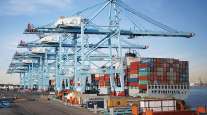Virginia Port Officials, Buoyed by State's $350 Million Aid, See Bright Future, Some Rough Water

PORTSMOUTH, Va. — For port followers, March 22 was a double-header: the Virginia Port Authority board held its every-other-month meeting, immediately followed by the annual State of the Port address.
“The pieces are in place,” said John Reinhart, the authority’s CEO and executive director, toward the close of a presentation that offered a breezy overview of the past year’s highlights, an update on goals and a sort of road map for what lies ahead.
At the board meeting, there was a nearly euphoric sense of gratitude in the wake of the General Assembly’s OK of a $350 million state-backed bond deal – driven by Gov. Terry McAuliffe – supporting the growth of the port’s biggest container terminal, Norfolk International Terminals.
Aubrey Layne, state transportation secretary, suggested at the meeting that it could well become “the shot heard ’round the world,” underscoring the seriousness of Virginia’s commitment to its port and the diversification of its economy.
The celebratory vibe was offset somewhat by reminders of the challenges ahead, inside the port and within the industry.
The authority is $5.6 million in the red for the first eight months of the July-to-June fiscal year; for the same period last year, it was $4.6 million in the black.
In July, McAuliffe heralded a double-digit million dollar, fiscal-year revival at the port – its first operating profit in seven years.
Reinhart said after the meeting that the authority had budgeted for a $100,000 loss for the first six months of fiscal year 2016; it made $726,000 in February, he added.
He tied the disappointing financial results to date to weak volume in November, December and January, coupled with expensive efforts to ensure that the congestion experienced a year ago didn’t recur – costly steps such as extending gate hours and expanding operations at Portsmouth Marine Terminal.
In the last calendar year, on a percentage basis, Virginia trailed the other big East Coast ports in year-over-year container-volume growth, measured in standard, 20-foot containers: the Port of New York/New Jersey was up 10.4%; Savannah, Georgia, 11.7%; Charleston, South Carolina, 10.1%; and the Port of Virginia, 6.5%.
The port’s slower volume growth last year was a function of the congestion that occurred last winter, Reinhart said. It illustrates how much the port needs the added capacity that the General Assembly’s action will help provide.
The money generated by the state’s bond deal will fund improvements at Norfolk International Terminals, enabling it to handle another 696,000 TEUs a year by 2019. Its current capacity is about 1.4 million a year.
Ports such as Savannah and Charleston have been steadily making such investments over the years to provide the capacity to handle cargo surges, port officials said.
Reinhart projected that steps now being taken will lead the authority to a break-even budget by the end of June.
Complicating the road ahead are dire economic conditions facing the big ocean carriers that shuttle containers from port to port around the world, said Tom Capozzi, the authority’s chief sales officer.
“They are all bleeding,” he told board members, adding that rates have been driven to the lowest levels he’s seen in years. “It’s really an unstable environment.”
Layne took a moment at the meeting to read aloud comments in a recent report by a Moody’s analyst, laying out how big the General Assembly’s $350 million bond deal is:
“The state’s $350 million injection is also credit positive in that it signals the state’s commitment to VPA,” Layne said, reading from the report. “The financial support within the plan is the largest amount of state aid earmarked for VPA in its 40-year history.”




